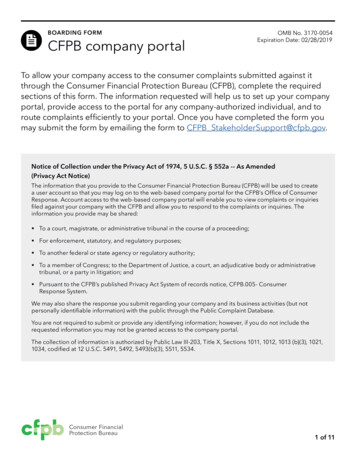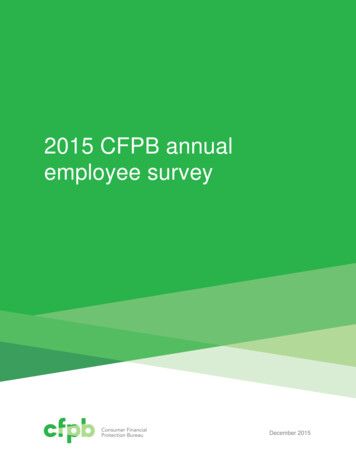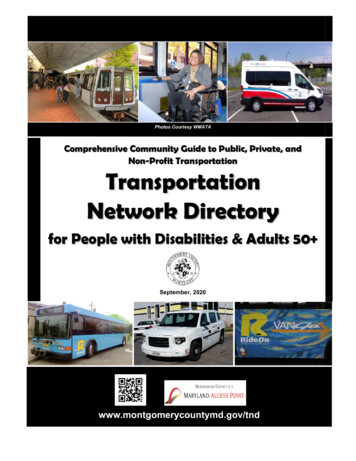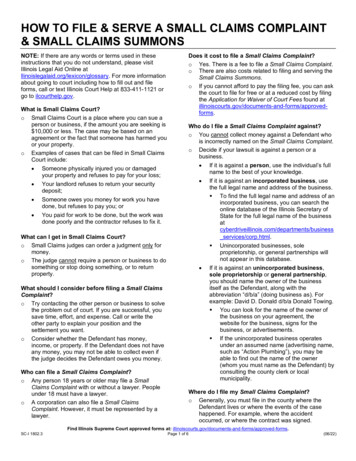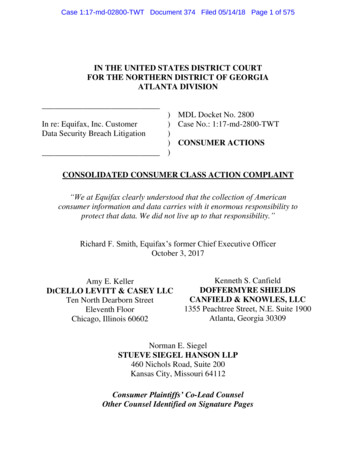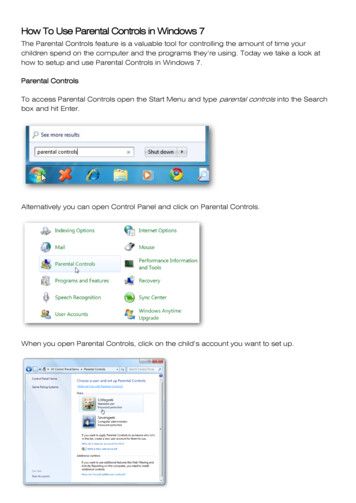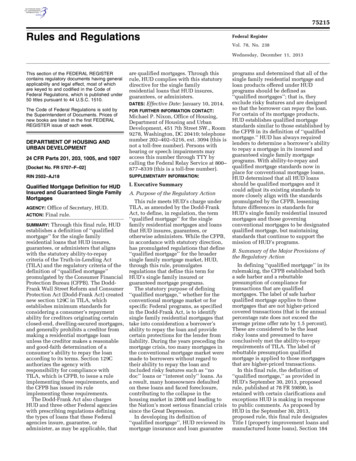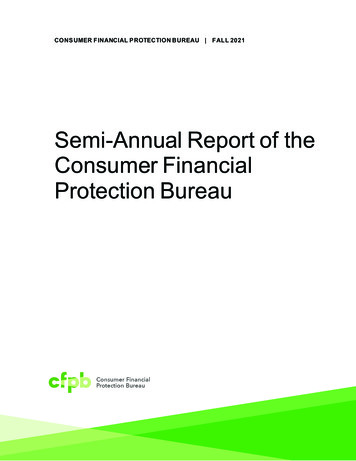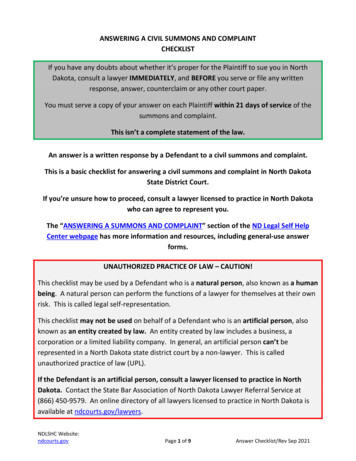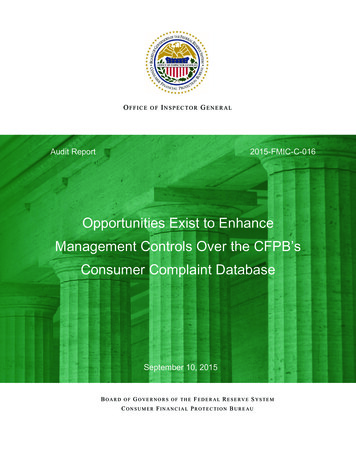
Transcription
OFFICEOFINSPECTOR GENERALAudit Report2015-FMIC-C-016Opportunities Exist to EnhanceManagement Controls Over the CFPB’sConsumer Complaint DatabaseSeptember 10, 2015BOARD OF GOVERNORS OF THE FEDERAL RESERVE SYSTEMCONSUM ER FIN ANC IAL PR OTEC TION B UR EAU
Report ContributorsSilvia Vizcarra, OIG ManagerJanice Buck, Project LeadVictor Calderon, Senior Forensic AuditorRebecca Kenyon, AuditorMichael Olukoya, AuditorEric Shapiro, AuditorCynthia Gray, Senior OIG Manager for Financial Management and Internal ControlsMelissa Heist, Associate Inspector General for Audits and EvaluationsAbbreviationsCFPBConsumer Financial Protection BureauConsumer ResponseOffice of Consumer ResponseDodd-Frank ActDodd-Frank Wall Street Reform and Consumer Protection ActDTData TeamGAOU.S. Government Accountability OfficeOIGOffice of Inspector GeneralQAQuality Assurance
Executive Summary:Opportunities Exist to EnhanceManagement Controls Over the CFPB’sConsumer Complaint Database2015-FMIC-C-016September 10, 2015PurposeFindingsThe Consumer Financial ProtectionBureau (CFPB) publicly disclosescertain consumer complaint datathrough its Consumer ComplaintDatabase, which is available on itswebsite. Our audit objective was toassess the effectiveness of theCFPB’s controls over the accuracyand completeness of the ConsumerComplaint Database. We evaluatedseveral of the CFPB’s managementcontrols relevant to the ConsumerComplaint Database. Our auditcovered processes performed fromJanuary 1, 2014, through June 30,2014, and included all complaintsin the Consumer ComplaintDatabase through June 30, 2014.We identified areas in which management controls should be improved to enhance theaccuracy and completeness of the Consumer Complaint Database. The Office ofConsumer Response (Consumer Response) has implemented controls to monitor theaccuracy of complaint data in the internal case management system, which contains allconsumer complaints received by the CFPB, but it has not established separatemanagement controls to ensure the accuracy of data extracted from the system andincluded in the Consumer Complaint Database. We found several noticeableinaccuracies in our analysis of the 254,835 complaints in the Consumer ComplaintDatabase as of June 30, 2014. Although the number of complaints with inaccuraciesthat we identified was relatively small, enhancing existing controls would help ensurethat as the number and types of complaints published increase, overall reliability of thedata is maintained.BackgroundThe CFPB’s Consumer ComplaintDatabase is intended to provideconsumers with timely andunderstandable information to helpthem make responsible decisionsabout financial transactions and toensure that markets for consumerfinancial products and servicesoperate transparently andefficiently. The database is updateddaily with complaint data that areextracted from an internal casemanagement system and thenpopulated to the CFPB’s internalData Team (DT) ComplaintDatabase. A file of publiccomplaint data is then generatedand published.We also found that Consumer Response does not (1) review all company closingresponses, including verifying whether the company-selected response is consistentwith the definition, and (2) consistently publish untimely company closing responses inthe Consumer Complaint Database. In addition, we found that Consumer Responseallows 60 days for consumers to dispute company responses, rather than 30 days asstated in Consumer Response publications. Further, consumers are not consistentlyoffered the opportunity to dispute untimely company responses. Finally, although theConsumer Complaint Database website asserts that complaint data are refreshed daily,we found that Consumer Response did not consistently notify the public when thedatabase was not updated. Consumer Response has resolved the causes for the majorityof the daily update failures that we observed, but it has not established procedures toinform the public when complaint data are incomplete or outdated.Because the DT Complaint Database plays a role in the daily update process, ourfindings should be considered in conjunction with the security control deficienciesassociated with the DT Complaint Database that were identified in OIG Report No.2015-IT-C-011, Security Control Review of the CFPB’s Data Team ComplaintDatabase, July 23, 2015. That report is restricted due to the sensitivity of its content,but a high-level summary is available on our website.RecommendationsWe are making recommendations to improve controls over the accuracy andcompleteness of the CFPB’s Consumer Complaint Database. In its response to our draftreport, Consumer Response concurs with our recommendations and indicates that it hasalready initiated actions to address them. Consumer Response also stated that itimplemented a system change to update the process for untimely company responsesand related consumer disputes, and it is replacing the DT Complaint Database.
Summary of Recommendations, OIG Report No. 2015-FMIC-C-016Rec. no.Report page no.115Implement controls to separately assess theaccuracy of complaint fields in the ConsumerComplaint Database.Office of Consumer Response215Formally document standards for the data entry ofcomplaints with foreign addresses.Office of Consumer Response315Implement the planned address verification tool toenhance the accuracy of consumer-providedlocation information in the Consumer ComplaintDatabase.Office of Consumer Response419Develop approaches for monitoring companyclosing responses to ensure consistency with theresponse definition.Office of Consumer Response519Verify the effectiveness of the recent systemchange to ensure that untimely company closingresponses, regardless of investigation status, arepublished.Office of Consumer Response623Formally clarify the time limit for consumers todispute company closing responses.Office of Consumer Response723Verify that the recent system change ensures thatOffice of Consumer Response827Recommendationa.consumers can dispute untimely companyclosing responses within a defined timeframe.b.consumer dispute data are properlypublished in the Consumer ComplaintDatabase.Develop and implement a policy that states whenthe public should be notified of ConsumerComplaint Database update failures and includesprocedures for the notification process.Responsible officeOffice of Consumer Response
September 10, 2015MEMORANDUMTO:Christopher JohnsonActing Assistant Director, Office of Consumer ResponseConsumer Financial Protection BureauFROM:Melissa HeistAssociate Inspector General for Audits and EvaluationsSUBJECT:OIG Report No. 2015-FMIC-C-016: Opportunities Exist to Enhance ManagementControls Over the CFPB’s Consumer Complaint DatabaseThe Office of Inspector General (OIG) has completed its final report on the subject audit. We conductedthis audit to assess the effectiveness of the Consumer Financial Protection Bureau’s (CFPB) controls overthe accuracy and completeness of its Consumer Complaint Database.We provided you with a draft of our report for review and comment. In your response, you concur withour recommendations. We have included your response as appendix B in our report.We appreciate the cooperation that we received from the Office of Consumer Response. Please contactme if you would like to discuss this report or any related issues.cc:Sartaj AlagStephen AgostiniJ. Anthony Ogden
ContentsIntroduction. 1Objective . 1Background . 1The Complaint Process . 2Consumer Complaint Database Overview . 5Relevant Regulations and Guidance. 11Finding 1: Additional Controls Are Needed to Enhance the Accuracy ofthe Consumer Complaint Database . 13Consumer Response Relies on Controls in the Internal Case ManagementSystem and Does Not Separately Assess the Accuracy of thePublic-Facing Consumer Complaint Database . 13Guidance for Processing and Publishing Location Data Is Limited . 14Management Actions Taken During the Audit . 15Recommendations . 15Management’s Response. 15OIG Comment . 16Finding 2: Opportunities Exist to Help Ensure the Accuracy andCompleteness of Company Response Data . 17Consumer Response Does Not Review All Company Closing Responses . 17Consumer Response Does Not Consistently Publish Untimely CompanyClosing Responses . 18Management Actions Taken During the Audit . 19Recommendations . 19Management’s Response. 19OIG Comment . 20Finding 3: Improvements Should Be Made to the Consumer DisputeProcess . 21Consumer Dispute Time Limit Is Not Consistent With Publicly DisclosedInformation . 21Consumer Response Does Not Consistently Allow Consumers to DisputeUntimely Company Responses . 22Management Actions Taken During the Audit . 23Recommendations . 23Management’s Response. 23OIG Comment . 24
Finding 4: Consumer Response Has Not Established Procedures forNotifying the Public of Update Failures . 25Consumer Response Did Not Consistently Inform the Public ofUpdate Failures . 25Management Actions Taken During the Audit . 26Recommendation . 27Management’s Response. 27OIG Comment . 27Appendix A: Scope and Methodology . 28Appendix B: Management’s Response . 33
IntroductionObjectiveOur objective for this audit was to assess the effectiveness of the Consumer Financial ProtectionBureau’s (CFPB) controls over the accuracy and completeness of its public-facing ConsumerComplaint Database. We conducted our audit using the following definitions provided inguidance issued by the U.S. Government Accountability Office (GAO): 1Accuracy refers to the extent that recorded data reflect the actual underlyinginformation.Completeness refers to the extent that relevant records are present and the fieldsin each record are populated appropriately.To accomplish our objective, we evaluated several of the CFPB’s management controls that arerelevant to the Consumer Complaint Database. Although in this audit we did not test the generaland application controls of the systems involved in complaint processing, the Office of InspectorGeneral’s (OIG) recent security control review of the Data Team (DT) Complaint Database,which supports the Consumer Complaint Database, tested the adequacy of selected informationsystem security controls. 2 The scope of the present audit covered processes performed fromJanuary 1, 2014, through June 30, 2014, and included all complaints in the Consumer ComplaintDatabase through June 30, 2014. Details on our scope and methodology are in appendix A.BackgroundThe Dodd-Frank Wall Street Reform and Consumer Protection Act (Dodd-Frank Act) created theCFPB to regulate the offering and provision of consumer financial products and services underthe federal consumer financial laws. The Dodd-Frank Act also gave the CFPB the authority toreceive complaints from consumers and to make public information about the markets forconsumer financial products and services. The CFPB exercises its discretion under this authorityto publicly disclose data from a subset of its consumer complaints through the ConsumerComplaint Database, which is available on its website at http://www.consumerfinance.gov/complaintdatabase. The Consumer Complaint Database is intended to provide consumers withtimely and understandable information to help them make responsible decisions about financialtransactions and to ensure that markets for consumer financial products and services operatetransparently and efficiently.1.U.S. Government Accountability Office, Applied Research and Methods: Assessing the Reliability of Computer-ProcessedData, GAO-09-680G, July 2009.2.Office of Inspector General, Security Control Review of the CFPB’s Data Team Complaint Database, OIG ReportNo. 2015-IT-C-011, July 23, 2015. This report is restricted due to the sensitivity of its content, but a high-level summary isavailable on our website.2015-FMIC-C-0161
The CFPB’s Office of Consumer Response (Consumer Response) is responsible for processingconsumer complaints. The CFPB uses consumer complaint data to help supervise companies,enforce federal consumer financial laws, and write rules and regulations. Consumer Responsereports to Congress about the complaints received and posts some complaint data, as described indetail below, in the Consumer Complaint Database. Complaint data are also shared with otheroffices within the CFPB, including the Division of Supervision, Enforcement, and Fair Lending,and with state and federal law enforcement agencies.The Complaint ProcessThe life cycle of consumer complaints received by the CFPB is depicted in figure 1. 3 These stepsare explained in greater detail below.Figure 1: Consumer Complaint ProcessSource: Consumer Financial Protection Bureau, Consumer Response: A Snapshot of Complaints Received July 21, 2011through June 30, 2014, July 16, 2014.Complaint SubmittedConsumer Response accepts consumers’ complaints through the CFPB’s website and by phone,postal mail, e-mail, fax, and referral. To facilitate the processing of consumer complaints,Consumer Response contracts for a secure case management system and contact centers. Thecontact centers handle calls from consumers, address consumer questions, accept complaintsubmissions, and provide the status of consumer complaints. All complaints, regardless of howthey are transmitted to Consumer Response, are processed through and maintained in the casemanagement system. Consumers can log on to a secure consumer portal to enter complaintsdirectly into the case management system and check the status of their complaints. The casemanagement system also contains other types of consumer records, such as inquiries andfeedback, which are processed separately from complaints. As of June 30, 2014, the casemanagement system contained 918,447 records, of which 432,121, or 47 percent, werecomplaints. The CFPB publicly discloses a subset of these complaints through the ConsumerComplaint Database, as described below.3.This section is a description of the complaint process in place at the time of audit fieldwork.2015-FMIC-C-0162
Complaint Reviewed and RoutedConsumer Response screens all complaints submitted by consumers and routes screenedconsumer complaints within the case management system to the appropriate company. To carryout its responsibility for accurately analyzing and routing complaints, Consumer Response hasimplemented several controls to monitor the accuracy of complaint data and detect problematiccomplaints in the case management system. Specifically, Consumer Response reviewscomplaints, monitors system queues, responds to system alerts, and completes Quality Assurance(QA) Scorecards for a sample of processed complaints. Consumer Response Review. All complaints submitted by consumers are screened toensure that they contain all necessary information and meet several conditions, includingthe publication criteria that are described below. For example, Consumer Responseassesses whether the complaint contains sufficient information to support the companyidentification. Complaints that do not meet these conditions may be returned to theconsumer for additional information or, for complaints that are not within the CFPB’sjurisdiction, referred to the appropriate regulator. According to Consumer Responsemanagement, this initial review ensures that complaints contain the informationnecessary for proper routing; it is not intended to identify inaccurate informationprovided by the consumer, unless such information prevents further processing. System Queues. After an initial review, complaints are routed to different queues withinthe case management system to progress through the complaint process. Queues arecollections of records that have been grouped together for further action. For example,the Company Review queue contains complaints that have been sent to companies for aresponse, and the Form Review queue contains complaints that are missing requiredinformation. In addition to routing complaints to queues, we determined that ConsumerResponse staff members monitor assigned queues, which helps to ensure that complaintsare processed correctly and in a timely manner. System Alerts. Consumer Response staff members respond to alerts, which are systemgenerated notifications of complaints containing anomalies. For example, some alertsidentify complaints with conflicting dates, such as a company response date that is earlierthan the date that the complaint was sent to the company. Other alerts detect incompleteor inconsistent fields, such as complaints that contain status information that is associatedwith an inquiry rather than a status that is associated with a complaint. To resolve analert, Consumer Response staff members manually review the associated complaint andupdate it, as appropriate, in the case management system. Although system alerts are notdesigned to prevent the continued processing, including publication, of an associatedcomplaint, we found that by monitoring them, Consumer Response improves the chancesthat as complaints are routed through the case management system, potential issues arecaught, promptly reviewed by staff, and corrected in a timely manner. QA Scorecards. The Consumer Response team leads document their reviews ofprocessed complaints by completing QA Scorecards. These weekly reviews areperformed to assess the accuracy and quality of a sample of processed complaints bychecking for duplicates, queue and field consistency, completeness, and properdisposition. The team leads make corrections in the case management system tocomplaints containing errors that are identified as a result of a QA Scorecard review. We2015-FMIC-C-0163
noted that completing QA Scorecards helps Consumer Response ensure that complaintsare processed accurately in the case management system.Company ResponseTo respond to a complaint, the company reviews the complaint information, communicates withthe consumer as needed, and determines what action to take. Companies have access to theircomplaints in the case management system via the company portal. Companies access thecompany portal to check for new complaints received from Consumer Response and to managecomplaints and submit responses to Consumer Response. Companies can also use the companyportal to report a technical issue or to notify Consumer Response of problems with a complaint bysubmitting an administrative response. If Consumer Response receives a complaint about acompany that does not have access to the company portal, Consumer Response staff memberscontact the company. The company then completes the required forms to participate, includingagreeing to time frames to respond to consumer complaints.Consumer ReviewConsumers can check the status of their complaints and view company responses via theconsumer portal. Consumers may provide feedback and dispute a company response with whichthey disagree by logging into the secure consumer portal or by calling the CFPB.Review and InvestigateConsumer Response reviews the feedback consumers provide about company responses to helpprioritize complaints for investigation. Complaints are sent to the Investigations section ofConsumer Response when the consumer disputes the company’s response or the company’sresponse is not timely. Consumer Response may periodically investigate other complaints basedon a review of the complaint, the company’s response, and the consumer’s feedback.For selected complaints, the Investigations section may ask companies and consumers foradditional documentation. The Investigations section then determines whether the companyviolated any federal consumer financial laws. If Investigations suspects a violation, the case isreferred to the CFPB’s Division of Supervision, Enforcement, and Fair Lending for furtherconsideration.Analyze and ReportConsumer Response periodically reports to Congress about the complaints received and alsoposts some complaint data, as described in detail below, in the public-facing ConsumerComplaint Database. Consumer Response also shares complaint data with other offices within theCFPB and with state and federal law enforcement agencies. According to the CFPB, it uses theinformation shared by consumers and companies throughout the complaint process to gain abetter understanding of what is occurring in the financial marketplace and to help the marketwork more efficiently for consumers.2015-FMIC-C-0164
Consumer Complaint Database OverviewThe CFPB released the public-facing Consumer Complaint Database on June 19, 2012.According to the CFPB, the Consumer Complaint Database is intended to help provideconsumers with “timely and understandable information to make responsible decisions aboutfinancial transactions” and to ensure that markets for consumer financial products and services“operate transparently and efficiently.” 4 The database allows the public to see what is beingcomplained about and why. Although the CFPB does not verify the facts alleged in complaints, ittakes steps to confirm the commercial relationship between the consumer and the company. Tradeassociations and companies have expressed concern that disclosing unverified consumercomplaints may open the data to manipulation and may unfairly damage the reputations ofcompanies. Alternatively, consumer groups have indicated that the data can help consumers todetect trends of unfair practices and that disclosure is a useful tool to improve the operation ofconsumer financial markets. The CFPB believes that the information presented has value to thepublic and that “the marketplace of ideas will determine what the data show.” 5The public-facing Consumer Complaint Database consists of a subset of the complaint data in theinternal case management system. Although only complaints that meet the CFPB’s publicationcriteria, which are described below, are contained in the Consumer Complaint Database, theinternal case management system contains both public and nonpublic complaints. In addition, theinternal case management system contains consumer complaints since July 21, 2011, when theCFPB began accepting them, while the Consumer Complaint Database includes data fromconsumer complaints submitted on or after December 1, 2011.As of June 30, 2014, the Consumer Complaint Database contained 254,835 complaints 6 fromconsumers submitted on or after December 1, 2011. These complaints involved a variety offinancial products and services, including bank accounts or services, credit cards, credit reporting,debt collection, mortgages, money transfers, private student loans, and vehicle or other consumerloans. Over time, the CFPB phased in additional products and services under its authority toexpand the services covered in the database. In the most recent additions, in July 2014 andJanuary 2015, the database was expanded to include (1) payday loans dating back to November 6,2013, and (2) prepaid cards, other consumer loans, and other financial services dating back toJuly 19, 2014.Data in the Consumer Complaint DatabaseThe public-facing Consumer Complaint Database contains anonymized complaint data providedby consumers, including the type of complaint, the date of submission, the consumer’s zip code,and the company that the complaint concerns. The database also includes information about theactions taken by a company in response to a complaint, including whether the company’s4.Consumer Financial Protection Bureau, Disclosure of Consumer Complaint Data, March 25, 2013,http://files.consumerfinance.gov/f/201303 cfpb laint-Data.pdf, aspublished in the Federal Register, 78 Fed. Reg. 21,218 (Apr. 10, 2013).5.Consumer Financial Protection Bureau, Disclosure of Consumer Complaint Data, March 25, 2013,http://files.consumerfinance.gov/f/201303 cfpb laint-Data.pdf, aspublished in the Federal Register, 78 Fed. Reg. 21,218 (Apr. 10, 2013).6.As of September 1, 2015, there were approximately 443,000 complaints in the Consumer Complaint Database.2015-FMIC-C-0165
response was timely, how the company responded, and whether the consumer disputed thecompany’s response. According to the CFPB, the Consumer Complaint Database does notinclude consumers’ personally identifiable information. The consumer complaint data displayedfor each field in the database is populated in one of three ways: generated by the case management systemprovided by the consumerprovided by the company involvedThe Consumer Complaint Database contains features to allow users to filter data based onspecific search criteria; to aggregate data in various ways, such as by complaint type, company,location, date, or any combination of available variables; and to download data. Table 1summarizes the 14 fields in the database at the time of audit fieldwork and the source for the datadisplayed in each field.2015-FMIC-C-0166
Table 1: Summary of Consumer Complaint Database FieldsNo.Field nameDescriptionDisplayedvalue typeData source1Complaint IDThe unique identification number assigned bythe t4Issue5Sub-issue6ZIP code7The type of product the consumer identified inthe complaint.The type of sub-product the consumeridentified in the complaint.The issue the consumer identified in thecomplaint.The sub-issue the consumer identified in thecomplaint.The consumer’s reported mailing zip code forthe complaint.Note: Includes only the first five digits and isblank for complaints submitted withnonnumeric values. Excludes zip codes forareas with populations of 20,000 or gory)Text(category)NumberConsumerSubmitted viaHow the complaint was submitted to theCFPB.Text(category)8StateThe consumer’s reported mailing state for te receivedThe date the CFPB received the complaint.Date10Date sent to companyThe date the CFPB sent the complaint to thecompany.Date11Company12Company response13Timely response?Whether the company gave a timelyresponse.Yes/No14Consumer disputed?Whether the consumer disputed thecompany’s he company about which the complaint isbeing made.How the company responded to sumeraText(category)CompanySource: OIG review of the CFPB’s Consumer Complaint Database.The CFPB authenticates the consumer’s identification of the relevant company and finalizes the entry as appropriate.aThe CFPB’s Publication CriteriaThe CFPB defines the following publication criteria for public complaints; complaints that do notmeet these criteria are not published, according to the CFPB. To be included in the public-facingConsumer Complaint Database, complaints must not duplicate another complaint by the same consumernot be a whistleblower complaintinvolve a consumer financial product or service within the scope of the CFPB’sjurisdiction2015-FMIC-C-0167
be submitted by a consumer who has an authenticated relationship with the identifiedcompanyThe CFPB provides a disclaimer on the Consumer Complaint Database website related to thecontent published. The disclaimer states that the CFPB does not verify all the facts alleged incomplaints but takes steps to confirm the commercial relationship between the consumer and thecompany. Specifically, the CFPB describes controls to ensure that complaints come f
report, Consumer Response concurs with our recommendations and indicates that it has already initiated actions to address them. Consumer Response also stated that it implemented a system change to update the process for untimely company responses and related consumer disputes, and it is replacing the DT Complaint Database.

